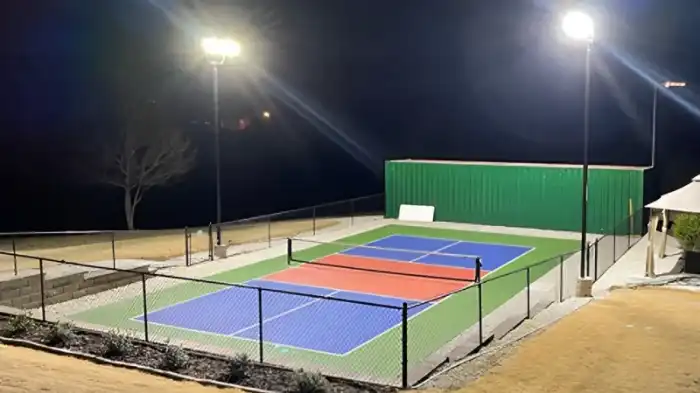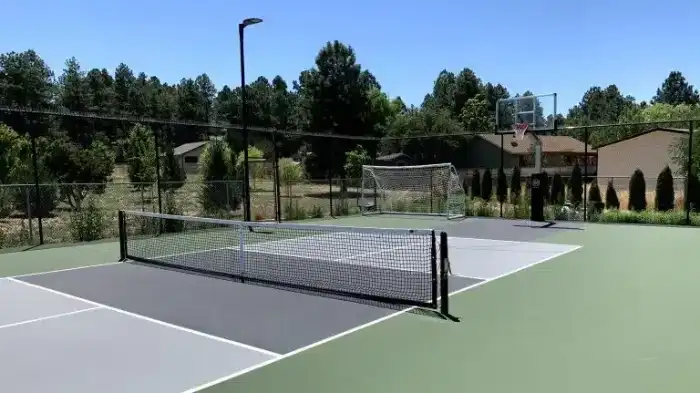Are you a pickleball enthusiast who wants to bring the game’s excitement to your own backyard? Building a pickleball court in your backyard can be a great investment, providing endless entertainment and a convenient place to practice your skills.
However, it is crucial to understand the ideal backyard pickleball court dimensions to ensure a fantastic playing experience on a backyard pickleball court. In this blog post, we are going to discuss the dimensions and requirements for building a backyard pickleball court.
Essentials and Backyard Pickleball Court Dimensions for Constructing a Backyard Pickleball Court
Backyard Pickleball Court Dimensions
Pickleball courts are typically 20 feet wide and 44 feet long, with a margin around the playing area. While these dimensions are standard for official competitions or dedicated pickleball facilities, the space available in your backyard might differ. In such cases, you can adjust the backyard pickleball court dimensions to fit your available space and still maintain the essence of the game.
The playing area should ideally be 30 feet wide and 60 feet long, ensuring enough room for competitive play. This size allows for strategic maneuvers, including the ability to move laterally and hit shots from various angles. However, if you’re limited by space, a court size of 20 by 44 feet can still provide an enjoyable playing experience.
Surface
A smooth and durable surface is essential for a good pickleball court. Ideally, the court should be constructed of asphalt or concrete. These materials offer excellent traction, allowing players to move swiftly and safely. Additionally, they require minimal maintenance and can withstand different weather conditions, making them suitable for year-round play.
It is important to ensure that the surface is free of any cracks or deformations that could pose a tripping hazard. Regular inspections and minor repairs will help maintain the integrity of the court and ensure a safe playing environment. Additionally, applying a textured paint or coating to the surface can enhance traction and reduce the risk of slips or falls.

Pickleball Net Height
The net is a critical component of any pickleball court, and its height plays a significant role in gameplay. The official net height for pickleball is 36 inches at the sidelines and 34 inches at the center. This slight variation compensates for the slight sagging that can occur over time.
When setting up a pickleball net in your backyard, it is crucial to ensure that it is securely fastened and at the correct height. This will provide a consistent playing experience and allow for fair competition. Adjustable nets are available on the market, making it easy to find the perfect net for your backyard court.
Court Markings
Properly marked courts are essential for both competitive play and recreational games. The court should have boundaries that clearly indicate the playing area and the non-volley zone. These markings are typically made with bright tape or painted lines. The markings on the pickleball court not only help players to understand the court’s dimensions but also ensure fair play and prevent disputes during matches.
The non-volley zone, also known as the “kitchen,” is a crucial component of pickleball. It is the area where players are not allowed to volley the ball directly from the air. It extends 7 feet from both sides of the net, providing a buffer zone for strategic shots and preventing players from crowding the net excessively.
Lighting
If you plan to play pickleball in the evening or during the darker months, proper lighting is essential. Illuminating your backyard pickleball court will allow for uninterrupted gameplay and reduce the risk of injuries due to poor visibility. LED floodlights are an excellent option for pickleball courts, as they provide bright and uniform lighting while being energy-efficient and long-lasting.
Frequently Asked Questions
Absolutely! While standard dimensions are 20 feet wide and 44 feet long, you can tailor them to fit your backyard. Aim for 30 feet wide and 60 feet long for an ideal competitive play area. But even with limited space, a 20 by 44 feet court can still deliver an enjoyable playing experience.
The official net height is 36 inches at the sidelines and 34 inches at the center. Ensure your net is securely fastened and at the correct height to maintain a consistent playing experience and allow for fair competition. Adjustable nets make this task easier.
Absolutely. Although it is not required, putting up a fence around your court can make it even better. Fencing helps to show where the court ends, stops balls from going everywhere, and gives it a more polished look. Think about adding a fence to make your court look nice and work well, just make sure it doesn’t get in the way of playing or cause any safety issues.
Regular inspections are key. Check for cracks or deformations that could pose tripping hazards. Perform minor repairs promptly, and consider applying a textured paint or coating for enhanced traction. Keeping the surface in top condition ensures a safe and enjoyable playing environment.
Conclusion
In the pursuit of mastering the game, understanding the backyard pickleball court dimensions is the key to transforming your outdoor space into a haven for pickleball enthusiasts. Whether you stick with the usual 20 by 44 feet or adjust the dimensions for your backyard, it is crucial to make sure that the surface is smooth and durable, the net height is right, the boundaries are well-marked, and the lighting is strategic.
These elements not only contribute to an enjoyable playing experience but also elevate your backyard court to a competitive arena. So, measure twice, construct wisely, and get ready to embark on a journey of endless fun and skill development right in your own backyard.

